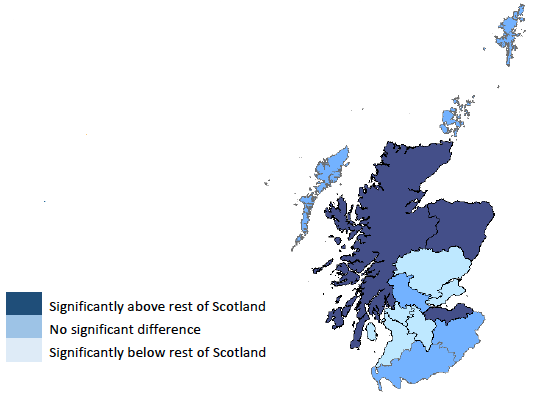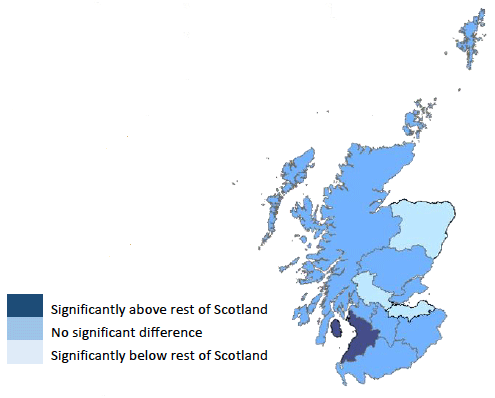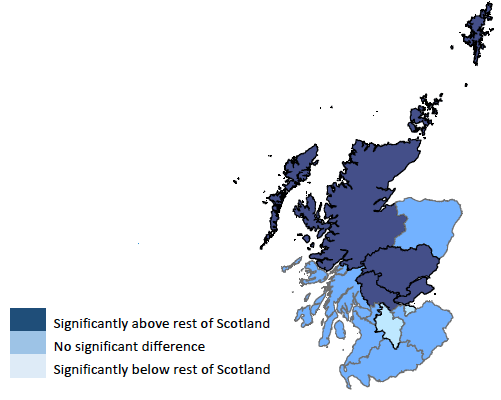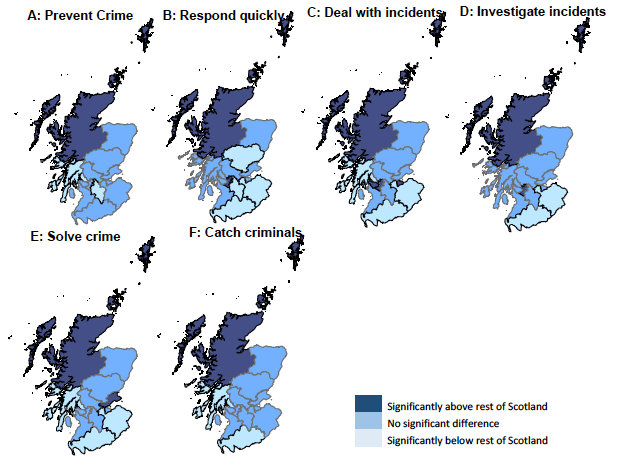Scottish Surveys Core Questions 2017
Official statistics publication on equality groups across a range of measures from harmonised questions in the major Scottish Government population surveys.
This document is part of a collection
4 Subnational Geographies
A key strength of the SSCQ is the ability to provide more detailed statistics for smaller geographies than its source surveys. In this section we examine subnational geographies relevant to each indicator, i.e. Health Boards and Police Scotland Divisions.
Results by Local Authority are available annually in the supplementary tables published alongside this report. Even more detailed results (e.g. electoral wards are published from multi-year datasets (mySSCQ).
Analysis
- Where statistical testing is used to identify differences, contrasts are constructed to compare each area to the national average excluding that area. (To check if, for example, Fife was significantly different to the rest of Scotland).
- Analysis in this section is not age-standardised. For more information about statistical tests, see section 6.10.
Subnational Geographies - Findings
- General Health
Self-assessed good/very good general health varied between 70% and 79% across health boards in 2017. Lower than average levels were reported in Ayrshire and Arran, Fife, Greater Glasgow and Clyde, Lanarkshire and Tayside Health Boards. Higher than average levels were reported in Highland, Lothian and Grampian Health Boards.
Tayside has seen a fall in those reporting good or very good general health, by seven percentage points since 2012 to 70% in 2017.

- Unpaid Care
There were relatively small differences between Health Boards in the proportion of adults providing unpaid care. Ayrshire and Arran (21%), Lanarkshire (21%) and Orkney (25%) reported rates higher than the national average in 2017. Dumfries and Galloway (12%) and Fife (15%) reported rates lower than the rest of Scotland.
- Smoking
Estimates of smoking rates across Health Boards do not deviate greatly from the national average (18%). Only Forth Valley was signficantly lower when tested against the rest of Scotland (14%).
In line with the fall in the national rate, nine of the Health Boards have seen significant falls in smoking rates since 2012.
- Limiting Long-Term Conditions
Ayrshire and Arran was the only Health Board reporting a higher than average proportion of adults living with a limiting long-term health condition (29%).
Lower than average proportions were reported in Lothian (19%), Forth Valley (21%) and Grampian (21%).
Orkney (+7 points), Tayside (+3 points) and the Western Isles (+5 points) health boards all showed increases in the proportion of adults reporting limiting long-term health conditions since 2012.

- Perception of Crime in Local Area
The highest levels for this indicator were found in Highlands and Islands Police Division (84%). Levels in Forth Valley (80%), Fife (79%) and Tayside (79%) were also above the national average.
Edinburgh (69%) and Lanarkshire (73%) reported levels below the national average.
Since 2012, Edinburgh (69%) and Lothian and Scottish Borders (68%) have seen falls in this indicator, by six and five percentage points respectively. In Highlands and Islands, a rise of two percentage points has been seen over the same period.

- Mental Wellbeing
Levels of mental wellbeing varied between 23.7 and 24.8 across health boards. There were higher than average levels of mental wellbeing as measured by SWEMWBS in Highland, Lanarkshire and Grampian Health Boards. Ayrshire and Arran, Greater Glasgow and Clyde, and Tayside all reported mental wellbeing scores below the Scottish average.
- Falls in mental wellbeing since 2012 have been reported in Greater Glasgow and Clyde (-0.3), Lothian (-0.5) and Orkney (-1.6), and since 2016 in Ayrshire and Arran (-0.6), Fife (-0.8) and Western Isles (-1.2). Confidence in the Police
- Police Confidence
- Highlands and Islands police division was above national average in all domains.
- Greater Glasgow police division was above national average in three of the six (B,C,D) and all domains have seen increased confidence since 2012.
- Dumfries and Galloway police division was below the national average in five domains (B,C,D,E,F), with confidence in these domains ranging from 54% to 60% in 2017. Since 2012, this area has seen falls in confidence in all domains of between 10 and 14 percentage points.
- Lanarkshire police division was below the national average in two domains (A – 51%, B – 61%), but have seen increases in four since 2012 (B,D,E,F).
- In Lothian and Scottish Borders, confidence has fallen in five domains since 2012 (A,B,C,D,E) and in four since 2016 (A,C,D,E). In 2017, four domains were below national average (B,C,D,E) with confidence in the ability of the police ranging between 53% and 66% across all six domains.
- Tayside has seen police confidence fall in three domains since 2016 (A,B,F). In 2017, the lowest levels of confidence in Tayside across the domains was in the ability of the police to prevent crimes (53%).
- In Arygll and West Dunbartonshire, confidence in the ability of the police across the six domains ranged from 43% to 70%, and was below the national level in four domains (A,C,E,F). Since 2012, this area has seen falls of 12, 15 and 5 percentage points in domains A, C and F respectively.

Contact
Email: sscq@gov.scot
There is a problem
Thanks for your feedback